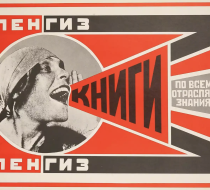Books (Please)! In All Branches of Knowledge, 1924 1 Favorite
Seattle Times:
In 1921, just four years after the Bolshevik Revolution, American journalist Albert Rhys Williams wrote: “The visitor to Russia is struck by the multitude of posters — in factories and barracks, on walls and railway-cars, on telegraph poles — everywhere.”
These posters were designed to catch the eye, stir the spirit and convince the mind. In bold reds, blacks and whites — and in a variety of styles from modernist abstraction to lyrical realism — they proclaimed messages about solidarity, the needs of the people and the corruption of the overthrown aristocracy and government.
One of the most recognizable of the posters in “Agitation and Propaganda: The Soviet Political Poster 1918-1929” at the Frye Art Museum is Alexander Rodchenko’s image of a woman joyfully shouting, “Books (Please)! In All Branches of Knowledge.”
Exhibition review
‘Agitation and Propaganda: The Soviet Political Poster 1918-1929’
11 a.m.-5 p.m. Tuesdays-Sundays, until 7 p.m. Thursdays, through April 3, Frye Art Museum, 704 Terry Ave., Seattle; free (206-622-9250 or fryemuseum.org).
Its appealing mash-up of photography with modern, geometric design has spawned countless riffs, from a 2005 album cover by Scottish band Franz Ferdinand to a 2014 version by artist David Redon with Beyoncé yelling “GIRLS.”
Most Read Entertainment Stories
Soundgarden and Vicky Cornell settle, paving way for new Soundgarden album
‘The Last of Us’ will film in B.C., but the game features these Seattle sites
'Beef' is a rare treat: A fresh take on Asian American representation
‘Fiddler on the Roof’ star Chaim Topol was a secret Mossad agent, family claims
'Midsummer' lets us see every element of Pacific Northwest Ballet
The original model was Lilya Brik, a member of Russia’s cultural avant-garde, who sports a simple kerchief, a sign of the peasant classes. A commission from the State Publishing House in Leningrad, the poster bolstered the new government’s image as committed to education and literacy.
If you visit this exhibition, and I suggest you do, pay attention to the “originally published by” information, which really drives the point home: The posters were created for and disseminated by government offices with names such as the “Political Administration of the Military Commissariat of Kiev.”
A complicated bureaucracy was emerging, along with a strategy to deploy propaganda in support of its goals. Both well-known and unknown artists were hired and stylistic experimentation ruled the day. The exhibition boasts excellent examples by El Lissitzky, Vladimir Mayakovsky and Nikolai Valerianov, among others.
Eventually, under Stalin, modern design was repressed and taken over by realistic, folk-heroic styles.
There are hints of what was to befall the USSR: authoritarian leadership and a complex system only superficially committed to equality and freedom. In one poster, Lenin himself, a vision in Communist red, stands amid a swirl of gun smoke, one hand pointed upward to the future, the other planted on the back of a crouching worker with a gun.
At the time, these messages must have been inspiring. There are calls for participation in the new state’s productivity and cries against anti-Lenin forces.
Dmitry Moor created a Russian equivalent to the Uncle Sam-as-recruiter image. A stern, Soviet-uniformed man looks directly at us, his finger pointed, demanding: “Have You Volunteered?” (J.M. Flagg designed his iconic “I Want You” Uncle Sam poster three years earlier, in 1917.)
Another poster by Moor — strikingly devoid of red in a very red exhibition — shows a gaunt man, all in white against a black background. His large hands extend straight up from thin wrists and his long torso is crossed with a single, fragile shaft of wheat. Blocky, uneven text pleads: “Help!” The poster was created in 1921 during a famine in which approximately five million men, women and children died.
These posters remind us that the post-revolutionary era was marked by calamity, unrest and struggles for power, but also bursts of optimism.
Another era also surrounds these images, another time of political and cultural unrest — the late 1960s. What you see on the Frye’s walls, in fact, are not the originals, but posters that were photographed and reproduced in 1967.
Italian photographer Caio Garruba was granted access to the posters in the Lenin State Library in Moscow and photographed them for their debut publication in the West. Grove Press, an American publishing house committed to radical literature and art, released the images in a book titled “Russian Revolutionary Posters, 1917-1929.”
And what about 2016? What do these posters mean now, almost 100 years later?
The poster-plastered visual landscape of Soviet Russia is not so far from our world, which is even more saturated with political and commercial messages.
While the posters of Soviet Russia were channeled through one strident voice — the state — the publicity of today is both cacophonous and hard to pin down. Countless corporations, causes and individuals embed innumerable appeals into our daily lives. Mixed messages are everywhere.
These posters also highlight the bombastic tone of America’s current presidential elections — and the jockeying for support via attention-grabbing images and grandstanding rhetoric.
Loud visuals and even louder sound bites create echo chambers of ideology that reinforce insular beliefs and allegiances. Comparisons with the past can cut through contemporary, persona-laden images to reveal the machinations of political marketing.
Agitation and propaganda are always worth keeping an eye on.








